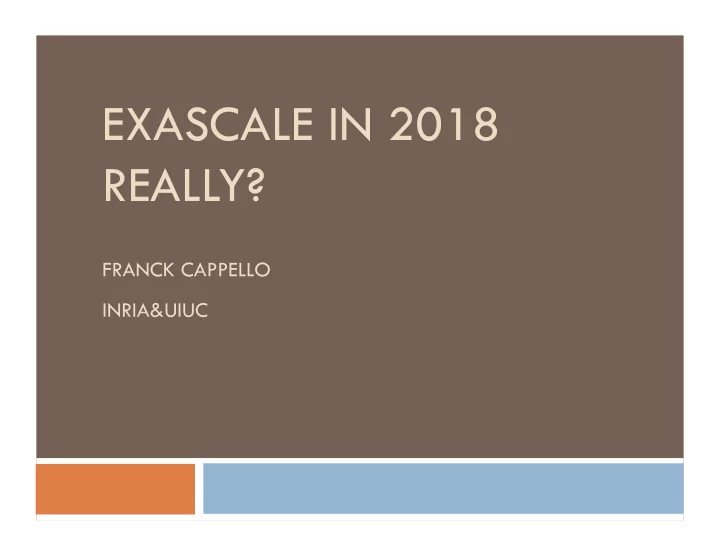

EXASCALE IN 2018 REALLY? FRANCK CAPPELLO INRIA&UIUC
What are we talking about? 100M cores 12 cores/node
Power Challenges Exascale Technology Roadmap Meeting San Diego California, December 2009. • $1M per Megawatt per year 20 MW Max (50 MW may be). • Flops are not really a problem: • FMA (fused multiply add) 100picojoules (Now), 10pj in 2018 (on 11nm lithography) Ok for architects • Memory bandwidth is critical (biggest delta in energy cost is movement of data offchip): • CPU Reading 64b operands from DRAM costs ~2000pj (now), 1000pj in 2018 2000W in 2018 (if 10TFfops/chip) for a ratio of 0.2 byte/flop. Not feasible 200W OK but 0.02 byte/flop (BW 0.5 byte/flop) /25 Need for more locality and less memory accesses in algorithms • Memory DDR3: 5000pj (read 64b word), DDR5 (2018): 2100 pj (JEDEC roandmap) At 0.2 B/flop, memory will need 70MW OR 0.02 byte/flop Need to develop new technologies for 0.2 B/flop but cost will be high • Network power consumption is critical: • Optical links consume about 30 ‐ 60pj/bit (Now), 10pj/bit in 2018 globally flat bandwidth across a system: Not feasible topology choice based on power (mesh topologies have power advantages) algorithms, system software, applications will need to be data locality aware
Application Challenges Application Programming: Hybrid multi-core (100-1000 Accelerator cores + 2-2 general purpose cores) hybrid programming will be required (MPI + threads, PGAS) Less memory per core (could become less than 1GB 512 MB/core) End of weak scaling, disruptive transition to strong scaling Less bandwidth for each core (0.02 Byte/flop could be required) Communication avoiding algorithms Applications candidates: • Many demanding applications that will need development efforts (next slide) • Uncertainty Quantification (UQ) Accurate model results are critical for design optimization and policy making Model predictions are affected by uncertainties: data, model param. (dust cloud…) UQ includes uncertainty information in simulations to provide a confidence level UQ investigations run ensemble of computational models of different configurations UQ generates a "throughput" workload of O(10K) to O(100K) jobs ("transaction”) However UQ generate a vast quantity of data (Exa Bytes), files and directories Database is required to keep the mapping between data, files, etc.
Application Challenges
Resilience Challenge Node architecture group Exascale Technology Roadmap Meeting San Diego California, December 2009: • The current failure rates of nodes are primarily defined by market considerations rather than technology • Because of technology scaling, transient errors will increase by factor of 100 x to 1000x. Vendors will need to harden their components • Market pressure will likely result in systems with MTTI 10x lower than today Today: 5-6 days for the hardware MTTI will be O(1 day). However software is also a significant source of faults, errors and failures Some studies consider that it is the main factor reducing the full system MTTI (Oliner and J. Stearley, DSN 2008, Charng Da lu, Ph. D thesis 2005): Bad scenarios consider full system MTTI of 1h…
RollBack/ Fail. Resilience Challenges IESP Oxford Critical Reco Avoid. Path April 2010 Uniquely Exascale: -Performance measurement and modeling in presence faults (Perf.) X Exascale plus Trickle down (Exascale will drive): Application successful execution & correctness (Masking approach) X X ? -Better fault tolerant protocols (low overhead) X X -Fault isolation/confinement + specific local management (software) X X -Use of NV-RAM for local state storage, cache of file syst. ? X -Replication (TMR, backup core) Pr. X -Proactive actions (migration), automatic or assisted? Application execution and result correctness (Non masking approach) X X -Domain Specific API and Utilities for frameworks Pr. X -Application guided (level) fault management X X -Language, Libraries, compiler support for resilience X X -Runtime/OS API for fault aware programming ¡(access ¡to ¡RAS, ¡etc.) X? X -Resilient Apps. + Numerical Libs & algo. (open question) Reliable System X X -Fault oblivious system software (and produce less faults) X X -Fault aware system software (notification/coordination backbone) X X -Prediction for time optimal checkpointing and migration X X -Fault models, event log standardization, root cause analysis X X -Resilient I/O, Storage and file systems X X -Situational awareness X X X Experimental env. to stress & compare solutions X Debugging ¡under ¡the ¡presence ¡of ¡errors/failures ¡+ ¡considering ¡faults Primarily Sub-Exascale (Industry will drive) X X -Fault isolation/confinement + local management (Hardware) X X -Checkpoint of Heterogeneous architecture
Exascale in 2018 Yes some hardware will probably be there BUT -what applications will be able to exploit even 5-10% of it with +Strong Scaling (lower memory per core) +Mesh topology +0.02 Bytes / Flop (0.2 if we are lucky) +MTBF of 1 hour (5h-10h if we are lucky) May be ensemble calculation (UQ) is the most likely “applications” to run first at Exascale problem: this is not an “Exascale” application in the sense of a single code running over the whole computer.
Recommend
More recommend